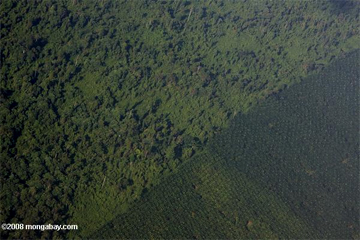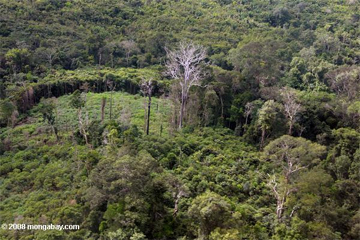Forest carbon payment programs like the proposed reducing emissions from deforestation and degradation (REDD) mechanism could put pressure on “wildlife-friendly” farming techniques by increasing the need to intensify agricultural production, warns a paper published this June in Conservation Biology.
The paper, written by Jaboury Ghazoul and Lian Pin Koh of ETH Zurich and myself in September 2009, posits that by increasing the opportunity cost of conversion of forest land for agriculture, REDD will potentially constrain the amount of land available to meet growing demand for food. Because organic agriculture and other biodiversity-friendly farming practices generally have lower yields than industrial agriculture, REDD will therefore encourage a shift toward from more productive forms of food production.
 Oil palm plantation: not so biodiversity friendly? |
“Land sparing, that is intensive farming on a smaller area of land, may offer more hope for meeting agricultural demands at lower costs to biological diversity than wildlife-friendly farming,” we write. “Because land productivity under intensive agriculture is high, the opportunity costs of REDD will rise, particularly as demand for commodities rises.”
We cite the expected demand for rubber as an example.
By 2050 growth in car ownership may necessitate production of 164 million metric tons of natural rubber for the tires alone, which would require 54 million ha of land under intensive rubber production or 161
million ha under lower-yield agroforestry production. In other words, the acreage requirements for low-yield, “jungle rubber” holdings are three times greater than industrial plantations.
 If “degraded lands”—often a euphemism for land that is used but not formally titled or is simply unclassified forest—are really as extensive as claimed by some countries, these might improve the prospects of organic farming approaches in a REDD-constrained world. |
Of course REDD may improve the viability of agricultural production on degraded lands, potentially relieving some of the pressure to intensify agriculture. Nevertheless the amount of land needed to meet forecast demand for food, fuel, and fiber is immense: 400-500 million hectares of new plantations and croplands may well be needed by 2050, assuming a 2-3 percent annual improvement in yields, a rosy scenario given the marginal productivity of most degraded lands.
So what is the future of wildlife-friendly farming techniques in a land-constrained world where forests are increasing pit against human consumption? We don’t pretend to know the answer.
While wildlife-friendly farming offers greater opportunities for carbon sequestration (potentially combining biodiversity and climate change mitigation goals), it suffers from lower yields than industrial approaches to food production, making meeting future demand from a hungrier and more populous humanity all the more challenging.
CITATION: Jaboury Ghazoul, Lian Pin Koh, and Rhett A. Butler. A REDD Light for Wildlife-Friendly Farming. Conservation Biology Volume 24, Issue 3, pages 644–645, June 2010
Related articles
80% of tropical agricultural expansion between 1980-2000 came at expense of forests

(09/02/2010) More than 80 percent of agricultural expansion in the tropics between 1980 and 2000 came at the expense of forests, reports research published last week in the early online edition of the Proceedings of the National Academy of Sciences (PNAS). The study, based on analysis satellite images collected by the United Nations Food and Agricultural Organization (FAO) and led by Holly Gibbs of Stanford University, found that 55 percent of new agricultural land came at the expense of intact forests, while 28 percent came from disturbed forests. Another six percent came from shrub lands.

(08/16/2010) Biochar—the agricultural application of charcoal produced from burning biomass—may be one of this century’s most important social and environmental revolutions. This seemingly humble practice—a technology that goes back thousands of years—has the potential to help mitigate a number of entrenched global problems: desperate hunger, lack of soil fertility in the tropics, rainforest destruction due to slash-and-burn agriculture, and even climate change. “Biochar is a recalcitrant form of carbon that will stay almost entirely unaltered in soils for very long periods of time. So you can sequester carbon in a simple, durable and safe way by putting the char in the soil. Other types of carbon in soils rapidly turn into carbon dioxide. Char doesn’t,” managing director of the Biochar Fund, Laurens Rademakers, told mongabay.com in a recent interview.
![]()
(05/04/2010) Most people who are trying to change the world stick to one area, for example they might either work to preserve biodiversity in rainforests or do social justice with poor farmers. But Dr. Ivette Perfecto was never satisfied with having to choose between helping people or preserving nature. Professor of Ecology and Natural Resources at the University of Michigan and co-author of the recent book Nature’s Matrix: The Link between Agriculture, Conservation and Food Sovereignty, Perfecto has, as she says, “combined her passions” to understand how agriculture can benefit both farmers and biodiversity—if done right.

(09/24/2009) With the world facing a variety of crises: climate change, food shortages, extreme poverty, and biodiversity loss, researchers are looking at ways to address more than one issue at once by revolutionizing sectors of society. One of the ideas is a transformation of agricultural practices from intensive chemical-dependent crops to mixing agriculture and forest, while relying on organic methods. The latter is known as agroforestry or land sharing—balancing the crop yields with biodiversity. Shonil Bhagwat, Director of MSc in Biodiversity, Conservation and Management at the School of Geography and the Environment, Oxford, believes this philosophy could help the world tackle some of its biggest problems.
Can carbon credits from REDD compete with palm oil?

(03/30/2009) Reducing emissions from deforestation and degradation (REDD) is increasingly seen as a compelling way to conserve tropical forests while simultaneously helping mitigate climate change, preserving biodiversity, and providing sustainable livelihoods for rural people. But to become a reality REDD still faces a number of challenges, not least of which is economic competition from other forms of land use. In Indonesia and Malaysia, the biggest competitor is likely oil palm, which is presently one of the most profitable forms of land use. Oil palm is also spreading to other tropical forest areas including the Brazilian Amazon.
Biodiesel demand could destroy world’s forests
(10/04/2007) Growing demand for biodiesel could drive large-scale forest conversion for energy crops, warns a study published in conservation Biology.